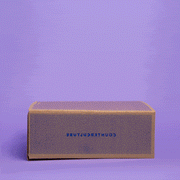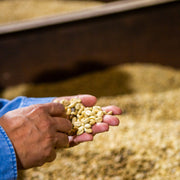Whether you’re new to specialty coffee or have been on board for a while, you’ve probably heard how important the freshness factor is.
What exactly do people mean when they say freshness is important, and what does it mean to say that a coffee is “fresh”? To answer these questions, we’re going to start at the beginning of the value chain with green coffee.

Freshness Begins At Origin
The way coffee is picked, processed, dried, stored, and shipped significantly impacts the longevity of coffee quality. Quality loss is measured by the degradation of the flavor of a coffee over time. This diminishment of flavor is referred to as “fade”, which is caused primarily by oxidation. No matter how well prepared and stored, any agricultural product’s quality suffers over time. Flowers wilt, apples get mushy, and bananas turn brown.
It's important to note that unless a coffee develops significant defects, it will almost always be drinkable once roasted. But let green coffee sit around too long, and it will lose its sweetness and acidity. It tastes flat and bitter becoming a caffeine transportation platform instead of a dynamic and delicious beverage.
Keeping Unroasted Coffee Fresh
Moisture Content
Many steps can be taken to slow fade down. We found that one of the most crucial aspects of green coffee stability over time is that it be dried to a moisture content between 9.5–10.5% after processing. This percentage is slightly lower than the general recommendation of ~12%. Lowering the moisture content before bagging and shipping helps green coffee to avoid pitfalls such as mold or physical degradation.
Transportation Storage
How coffee is stored also has a major impact on its lifespan. Historically coffee was transported in porous jute bags, leaving the beans fully exposed to the effects of oxidation and the potential of water getting in from the ocean or rain. Now, we will generally have coffee packaged into a material called Grainpro, which is significantly less porous and prevents too much air from coming into contact with the beans. In cases where the retention of quality is of utmost concern, we will ask for coffee to be vacuum sealed before shipment.
Roasting on Arrival
Ideally, it is best to roast coffee as soon as possible after it arrives from origin. In most cases, that means the coffee will be used within four months of arrival. But depending on a few other factors like origin and bean variety, and if everything went well up to the point of the coffee’s arrival in the US, sometimes green coffee will remain high quality for up to a year. That determination is always made by our coffee department, which regularly controls our coffee menu. If something isn’t good enough to remain on the menu, a coffee can be pulled early, and we will find other ways to utilize those beans.
Keeping Roasted Coffee Fresh

Moving from unroasted to roasted coffee, there are two main factors to consider that impact freshness – when the coffee was roasted and how it is stored once the bag is opened. Coffee is similar to other raw ingredients you might have in your kitchen. Properly stored, the flour will remain good to use for many months. But once you bake it into bread, the quality of the finished product will diminish in a matter of days, if not hours.
Brewing After Roasting
For peak flavor, coffee should be used within 2–4 weeks after roasting. Like with green coffee, roasted coffee never gets so bad you can’t brew it up and drink it. We’ve all tasted coffees that were roasted long, long ago. Something from a can? A convenience store on the side of the highway? Dad’s kitchen? And everything’s fine, right? Sure, but that almost certainly wasn’t a tasty, sweet coffee. Stale coffee rarely gives you an 'ah-ha' moment.
Letting Coffee Rest
Another factor to consider when thinking about freshness is how long coffee should “rest” after roasting. Why wait to brew it up? If fresh coffee is good, wouldn’t fresher coffee be better? Not necessarily. Letting coffee rest allows carbon dioxide gas – built up and stored in the beans during the roasting process – to escape. This enables more efficient, even brewing and results in more-balanced and sweet coffee. Brew too soon after roasting, and you will almost certainly taste a particularly bitter, roasty note. Let it rest, and things mellow out.
Rest is crucial with espresso! When brewing espresso, there is usually a lot of coffee packed into a tight basket, and a comparatively small amount of water is being forced through it. If there is a lot of gas still trapped in the coffee from roasting, it will interfere with water absorbing into the grinds, and you’ll get unevenly extracted, gassy brews (nobody wants a gassy brew!). They taste bitter, often thin, and all around unpleasant. So what to do?
The general convention has been that you should start using a coffee 3–5 days off roast for brewed coffee and 5–7 days for espresso. While these are helpful guidelines, as the specialty coffee industry has shifted toward purchasing more-dense green coffee grown at higher elevations and roasting lighter, the optimal window to start using roasted coffee is wider than ever before. Sometimes these coffees really open up two or three weeks after roasting. Experiment for yourself! Take note of how your coffee changes over a week, and you’ll be able to find the optimal window, with that coffee, for you!
You should also consider this longer ideal roast window when you purchase coffee at your favorite coffee shop. You don’t usually bring green bananas home from the grocery store and expect to eat them that day, right? The standard convention of “fresh as possible” certainly gives you options, but maybe bringing home a coffee roasted yesterday is not ideal. That bag roasted a week ago may actually just be coming into its literal and metaphorical sweet spot. And be sure to look for a “Roasted On” date rather than a “Best By” date. We print both on our bags, but the roasted on date is the one you will want to consider.
In short, our coffees taste great for a wider window of time than ever before.
Storing Coffee Beans At Home
Now that you’ve got that amazing coffee bag home and brewed your first cup, how should you store the beans? While there are several opinions on how to store coffee, our best recommendation is to keep whole bean coffee either in the original packaging—sealed tightly with the excess air forced out of the bag via the one-way valve—or in an airtight container that allows carbon dioxide to escape without letting oxygen in. In either case, coffee should be stored in a cool, dry space and away from direct sunlight.
Once the bag is opened, it’s best to use the coffee within two weeks for best results. The bag and one-way valve keep coffee fresh as long as it is sealed for quite a long time. Once the bag is opened, quality will start to drop quickly.
Avoid storing opened coffee in the fridge or freezer. Coffee is very porous and easily absorbs moisture, along with any odors that may be hanging around. You don’t want that chocolate-y sweet coffee taking on the flavors of last night’s fish!
Now armed with that information; hopefully, you will feel more confident when you’re out there in the world buying coffee. If you want the freshest coffee experience possible, consider subscribing to Counter Culture Coffee! Coffee is roasted daily and can get almost anywhere in the US within 3-5 days. That lines up pretty perfectly with those freshness guidelines… I wonder if we planned it that way?







